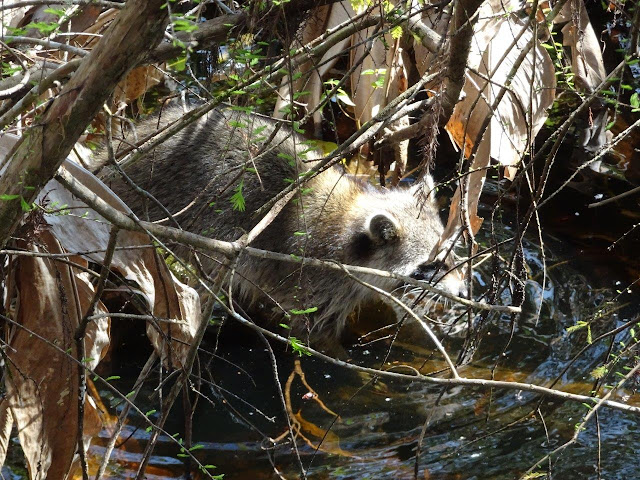This is a list of the birds that were seen today. Unfortunately, birding is best in the early morning, but I was on my way between campgrounds and did not get here until noon.
The boardwalk is a 2.5 mile stroll, although there is a shortcut that cuts the length down by half. Lots of benches on the walk. Please wear rubber-soled showed, however, and whisper so you do not scare the birds.
This red-shouldered hawk was right at the beginning of the boardwalk.
A group of us watched this raccoon snooping through the shallow water looking for crustaceans and anything else edible. He was not at all concerned about the crowd he gathered.
The sign said this was a rabbit's foot fern. It leaves are ruffled a bit but not deeply grooved as Boston ferns, in the second photo.
Boston ferns in much better shape than the ones I used to try to grow indoors.
Part of the boardwalk. To the left is wet prairie and to the right are bald cypress trees. They are called "bald" because they lose their leaves in the winter.
Sword ferns, I think.
This is one of the largest bald cypress, but it has a strangler fig growing up its trunk.
Same free, but you can see how the strangler fig has reached almost the top.
Wet prairie. Home to deer, bear, cougars, and all sorts of animals.
An unpolluted swamp will have crystal clear water and hardly any mosquitoes, because tiny dish eat mosquito larvae in a real swamp. It should be think in plants and wildlife, including birds, lizards, alligators, snakes, mammals, and more.
Great blue heron.
This is swamp lettuce. Not edible, however.
The purple gannanule is walking on the "lettuce" leaves. He is looking for small minnows he can sneak up on. He has multi-color iridescent feathers.
This is a little blue heron. He is about half the height of a great blue heron and light enough that he also can walk on top of floating leaves and sticks.
He also eats small minnows. The minnows, which are very common in the swamp, eat mosquito larvae, keeping a healthy swamp fairly mosquito free. 
And the only alligator I saw--but a really, really big one. He is not only long, but very thick, so likely to be very old.
Look at the beautiful breeding plumage on the front of this great blue heron! We don't often see this is northern states. These and other wading birds once almost went extinct because ladies liked to put their feathers on their hats.
And another raccoon doing his raccoon-things.
You can tell how old the boardwalk is. This tree grew right up to and over the railing.
This green lizard did not like me looking at him, so he kept moving to the opposite side of the tree!
























No comments:
Post a Comment